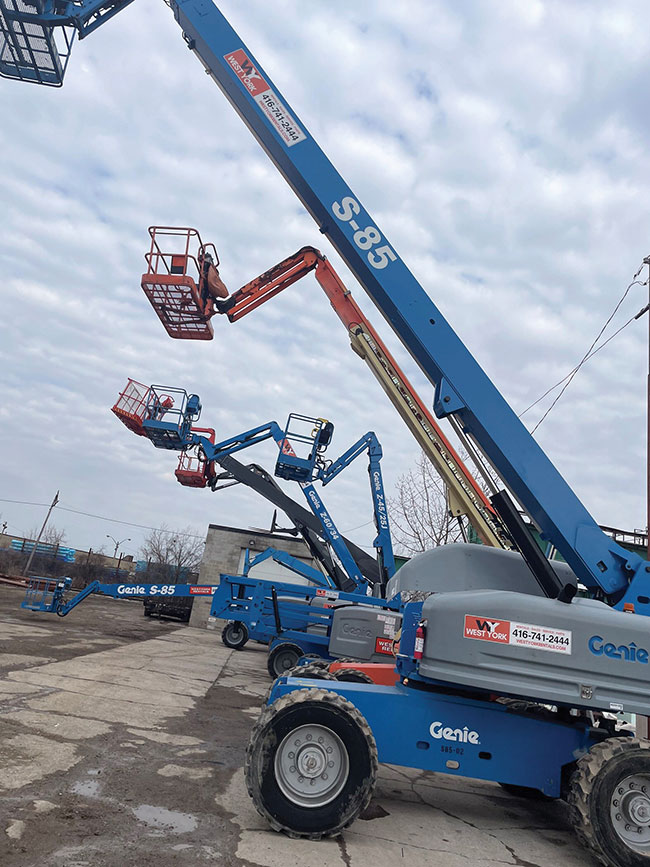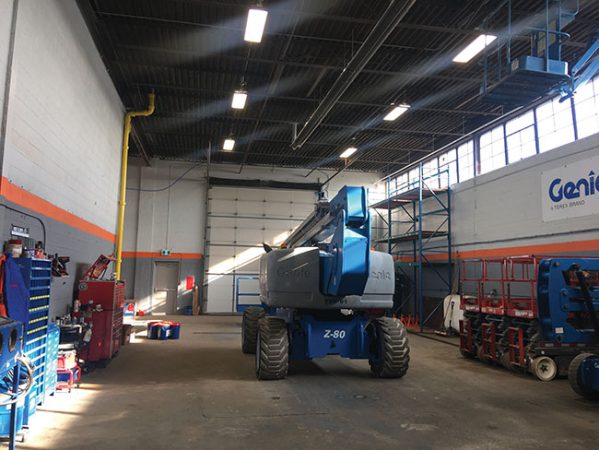
Top tips on safely operating aerial equipment in all of Canada’s elements
By Andrew Snook
Features Tech tips aerials equipment rental terrainEnsuring the stability of aerial equipment
 Mobile elevating working platforms have a specific angle limit when elevated. Check the operator’s manual for individual machines.
All photos courtesy of Westyork Rentals
Mobile elevating working platforms have a specific angle limit when elevated. Check the operator’s manual for individual machines.
All photos courtesy of Westyork Rentals When operating aerial equipment on rough terrain worksites, ensuring the stability of the equipment is vital to keep workers safe.
One of the first questions operators should ask themselves is: how much grade is safe to operate on?
“For mobile elevating working platforms, ground slope is a major contributor to machine stability and, ultimately, the operator’s safety,” says Tony Groat, regional manager for North America for the International Powered Access Federation.
He says it’s important to note that having a high gradeability (drive in stowed position) does not mean the machine can operate on this same angle when elevated.
“All MEWPs have a specific chassis angle limit when elevated, which is specified in the operator’s manual for the individual machine,” he says. “The operating chassis angle is the gradient at which the machine will elevate to full height. This is typically five degrees or less for most common machines. This may increase to around 10 degrees for machines with outriggers or stabilizers.”
While gradients of five to 10 degrees are typical for gradients at which machines will elevate to full heights, there are a few exceptions.
“There are specialized MEWPs in the market that can operate on steeper gradients, as much as 20 degrees,” Groat notes.
He says there are mandatory design changes in the 2018 to 2021 design standards in ANSI A92 and CSA B354 standards where there is a requirement for boom lifts to stop functions when the machine’s chassis angle exceeds its approved rating and the operator is at height.
“Chassis slope can be affected by both the angle of the surface under the boom but also by obstacles above the ground that the tires are on top of, such as raised sidewalks, jobsite ramps and uneven ground surfaces. In order to accurately measure chassis angle, an inclinometer or a manual slope calculation and conversion is needed,” he adds. “MEWP users and operators need to understand the equipment needs of each site application, as certain jobs may require adding ground cribbing or even a larger boom lift with a longer outreach from chassis to platform to reach over steeper sloped surfaces.”
If an operator needs to move across or work at an incline, Groat recommends they install an inclinometer app on their phone.
“Search ‘inclinometer’ on your Google Play or App Store for a multitude of available options. This allows you to ID the slope of your chassis prior top elevating,” he says.
Uneven terrain
When it comes to working on uneven ground, how much is too much?
“As long as the machine can drive over it, you’ll be okay. I mean, if you have a 12- or 13-inch drop, what’s going to happen is you’re probably going to bottom out the axles of the machine and then you’re going to get stuck. Now, would the boom operate on that? Sometimes they will operate. Is it going to be restricted? Yes. If the boom feels that it’s unsafe it’ll probably let you go up, for example, 10 feet, but if it’s 45 feet, it will not let you go up because it feels that it is unstable,” explains Frank Pinto, co-owner of Westyork Rentals. “Usually, when the ground is really off, what we do is we recommend a bigger machine, so you don’t have to go into real uneven conditions.”
Groat adds that MEWPs designed under new 2018 to 2021 design standards required boom lifts to have function cutouts when slope limits are reached in addition to alarms, only allowing for movement of the machine away from the limits.
“Approved cribbing may also be used to create a level surface for safe boom operation when surface angles are too great,” he says. “When used as instructed by a qualified person, site constructed cribbing may bring a workplace surface to within the acceptable limits for MEWP operation as described in the operator’s manual.”
For added safety, operators should limit stowed travel speeds according to the conditions and surface traction of the slope and never raise, extend or operate the MEWP until it is on a firm, level surface.
Windy conditions
When it comes to navigating windy conditions, Pinto says it will depend on the height of the machine and the site it is operating on.
“The bigger the machine, the more sensitive to wind it’s going to be. We have booms that can reach up to 180 feet. That’s 19 storeys. So, on a windy day, I wouldn’t want to be caught on top of that machine. You would have to go by the owner’s manual, or the operator’s manual, and see exactly what it’s going to be,” Pinto says. “If the wind goes over a certain amount, it’s not safe to be on a machine. Typically, the 55s (55 feet) and the 65s (65 feet) are not bad. But when you start getting to 80, 100, 180 feet, then it gets scary up there on a windy day.”
Groat says MEWPs’ designed stability includes calculations for wind loading, and that wind speed at the platform can be measured using a hand-held anemometer.
“An inside MEWP may only be used in work areas with zero exposure to wind while outdoor MEWPs are designed for wind loading up to 28 miles per hour when the MEWP is elevated,” he says. “The MEWP user must instruct the operator to not operate the machine in strong or gusty winds or increase the surface area of the platform or the load. Increasing the area exposed to the wind will decrease machine stability so extreme care must be taken when handling glass or wood panels, cladding or other materials that may act as a sail. Operators should only use approved attachments and accessories, and always adhere to the instructions for the attachments safe use.”

Using outriggers
Some units are equipped with outriggers designed to create additional stability for the machines. These should always be used as recommended by the manufacturer.
“Before elevating the work platform, you should ensure that the machine is leveled within the manufacturer’s limits and located on a firm surface. The use of suitable cribbing should always be considered when it is necessary to spread the load under the outriggers to prevent them from either sinking into the ground, damaging the supporting surface, or sliding/moving under load. You should check that each outrigger and its cribbing is in full contact with the ground, both before starting work and regularly thereafter. If you are in doubt about the ground conditions at any time, you must consult a qualified person,” Groat says.
He adds that some ground types may be suitable for handling the pressure generated by the outrigger.
“The area of the foot attached to the outrigger of a MEWP is relatively small and consequently generates high pressures on the ground. Most soils, unmade ground and some paved and tarmac-covered areas are not capable of supporting these pressures and some form of foundation or spreader pad is often required to reduce the pressure to an acceptable level,” Groat says.
He adds that regular checks should be made on ground conditions after substantial rainfalls and during thaws.
“Heavy or prolonged rain can alter ground conditions and cause sinking of outriggers or wheels. If it is suspected that the ground supporting a MEWP is getting softer, regular checks should be made on machine level and the appropriate adjustments made to outriggers and packing mats,” he says. “Regular checks should be carried out when frozen ground is thawing out since frozen ground can appear to be much firmer than it actually is.”
Tire types
Tires can come in a wide variety of sizes, colours and tread patterns, as well as different levels of hardiness. The easiest way to ensure the right tires are on a piece of aerial equipment is consult the owner’s manual.
“You have to go with tires that are based on the specs of the machine,” Pinto says.
Groat says it is critical to understand how important tire selection is to MEWP stability.
“A replaced tire that is too hard or too soft will impact the way the machine contacts the ground, potentially affecting the stability of the load above. And, a replaced tire that weighs more or less than original equipment affects the machine’s counterbalance, which potentially impacts the machine’s load rating,” he says.
While OEM tires may come with a higher upfront price tag, they also come with a level of certainty when it comes to their performance.
“While cheaper versions may be found, use of OEM genuine parts are tested and verified specifically for your MEWP fleet and eliminate risk associated with incorrect tires that do not meet stability requirements,” Groat says.
Although it likely seems obvious to most people, it is important to note that proper maintenance of tires will also help ensure stability.
“Maintaining the condition of your MEWP’s tires and wheels is essential to safe operation and good performance. Tire damage and/or excessive wear can affect machine performance and stability. Component damage also could result if problems are not discovered and repaired in a timely fashion,” Groat says. “A visual inspection can tell you whether your tread depth is sufficient, as well as whether if there is any sidewall damage. Your machine’s wheel decals and operator’s service and parts manual can provide details specific to your model. Please refer to specific requirements for your machine, and a qualified tire repair technician, for tire repair.”
Print this page
Leave a Reply